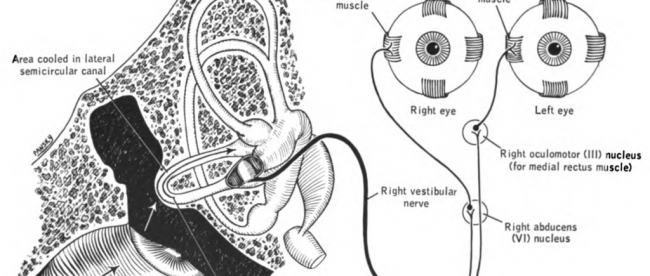The Temperature-Detecting Trick Our Eyes and Ears Can Play

The term “caloric stimulation” sounds like a medical term, probably because it is one. But it has nothing to do with eating an absurd amount of apple pie, unfortunately. On the plus side, it’s evidence that our ears can detect differences in temperature — and our eyes are their thermometers.
Let’s say you get some water in your ear. Other than an uncomfortable feeling, what do you expect to happen? You probably don’t expect your eyes to start jumping around uncontrollably. But they might — and not only is it normal, but expected. And even weirder, the direction the jump will be determined by the temperature of the water.
Let’s start with cold water — ice cold, not tap water cold. If you insert it into the subject’s ear canal, you’ll end up with a reaction. First, the person’s eyes will move slowly toward the now-wet ear, but then the eyes jump rapidly away — a reflex called a nystagmus — as seen in the video below. (If the video doesn’t appear, click here to check it out.)
Repeat the test with warm water (after drying out the ear, of course), and the nystagmus happens again. But this time, the eye jumps toward the ear being tested. That’s how we read the binary eye-thermometers — when the ear detects cold water, the eyes move away from the ear; when the ears meet warm water, the eyes move toward it. (Doctors and audiologists have a neat mnemonic for this, in COWS — cold opposite, warm same.)
The reason for the difference: convection currents, just like those found in an oven. Cold water causes currents which flow in one direction while warm water causes currents which flow in the other way, and the eyes react accordingly. The end result is that eyes jump as the currents demand: cold toward the opposite eye, warm toward the same. It’s looks like a neat little magic trick, although the eye movements are hard to detect from a distance.
But it’s more than just a trick — it’s an important medical diagnostic tool, too. Each one of us has a vestibular system, which Wikipedia describes as “the sensory system that provides the leading contribution about the sense of balance and spatial orientation for the purpose of coordinating movement with balance.” For most mammals, and humans in particular, a major part of our vestibular systems are situated within our inner ear — that’s why an ear infection can often lead to dizzy spells. The vestibulocochlear nerve, more commonly referred to as the auditory nerve, is the area of the ear that transmits balance information to our brains.
But sometimes, the system can malfunction, and caloric stimulation can help us figure out what’s going on. If the patient’s auditory nerve is damaged — and potential reasons that could be the case are numerous and diverse (but here’s a list) — the nystagmus will either not be present or COWS will be mixed up and be more like SCOW.
So if you really want to try this out, make an appointment with a doctor — , don’t try it at home. But even that is not recommended unless medically necessary — while making your eyes jump may sound cool, most people who have undergone a caloric stimulation test report dizziness, nausea, and sometimes fainting spells and vomiting.
 Bonus Fact: The same test can be used to see if comatose patients are brain dead — something which is often difficult to measure due to the lack of brain activity and outward responses to stimuli. For comatose patients, the eyes will still move — caloric stimulation is a test of reflexes, and not a conscious movement — although typically without the nystagmus, as Wikipedia notes. But if he eyes remain still, the patient is probably brain dead, as there’s no reflex reaction present.
Bonus Fact: The same test can be used to see if comatose patients are brain dead — something which is often difficult to measure due to the lack of brain activity and outward responses to stimuli. For comatose patients, the eyes will still move — caloric stimulation is a test of reflexes, and not a conscious movement — although typically without the nystagmus, as Wikipedia notes. But if he eyes remain still, the patient is probably brain dead, as there’s no reflex reaction present.
Double bonus!: There’s a slight chance that you can vibrate your eyes rapidly from side to side on demand. (If you can, you know it. As someone who can, take my word for it.) This, like the above, is also a nystagmus, but a voluntary one. Per one study, eight percent of the population has a voluntary nystagmus and it likely has a hereditary element.
From the Archives: Recessive Earwax: Earwax comes in two types, and the type you have is determined genetically.
Take the Quiz: One one, two twos, three threes, and so on. It’s easy in theory, but your eyes probably will quit on you before the five minute timer expires.
Related: “All Children Have Different Eyes: Learn to Play and Make Friends,” an out of print book teaching children that it’s okay to play with children with an involuntary, persistent nystagmus (among other differences).
